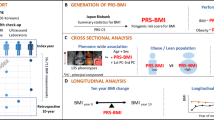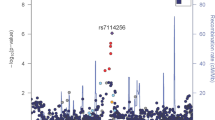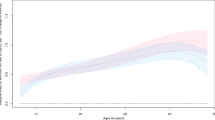Abstract
Background:
Recent cross-sectional genome-wide scans have reported associations of 97 independent loci with body mass index (BMI). In 3541 middle-aged adult participants from the GLACIER Study, we tested whether these loci are associated with 10-year changes in BMI and other cardiometabolic traits (fasting and 2-h glucose, triglycerides, total cholesterol, and systolic and diastolic blood pressures).
Methods:
A BMI-specific genetic risk score (GRS) was calculated by summing the BMI-associated effect alleles at each locus. Trait-specific cardiometabolic GRSs comprised only the loci that show nominal association (P⩽0.10) with the respective trait in the original cross-sectional study. In longitudinal genetic association analyses, the second visit trait measure (assessed ~10 years after baseline) was used as the dependent variable and the models were adjusted for the baseline measure of the outcome trait, age, age2, fasting time (for glucose and lipid traits), sex, follow-up time and population substructure.
Results:
The BMI-specific GRS was associated with increased BMI at follow-up (β=0.014 kg m−2 per allele per 10-year follow-up, s.e.=0.006, P=0.019) as were three loci (PARK2 rs13191362, P=0.005; C6orf106 rs205262, P=0.043; and C9orf93 rs4740619, P=0.01). Although not withstanding Bonferroni correction, a handful of single-nucleotide polymorphisms was nominally associated with changes in blood pressure, glucose and lipid levels.
Conclusions:
Collectively, established BMI-associated loci convey modest but statistically significant time-dependent associations with long-term changes in BMI, suggesting a role for effect modification by factors that change with time in this population.
This is a preview of subscription content, access via your institution
Access options
Subscribe to this journal
Receive 12 print issues and online access
$259.00 per year
only $21.58 per issue
Buy this article
- Purchase on Springer Link
- Instant access to full article PDF
Prices may be subject to local taxes which are calculated during checkout
Similar content being viewed by others
References
Hubert HB, Feinleib M, McNamara PM, Castelli WP . Obesity as an independent risk factor for cardiovascular disease: a 26-year follow-up of participants in the Framingham Heart Study. Circulation 1983; 67: 968–977.
van Kruijsdijk RC, van der Wall E, Visseren FL . Obesity and cancer: the role of dysfunctional adipose tissue. Cancer Epidemiol Biomarkers Prev 2009; 18: 2569–2578.
Sullivan PW, Morrato EH, Ghushchyan V, Wyatt HR, Hill JO . Obesity, inactivity, and the prevalence of diabetes and diabetes-related cardiovascular comorbidities in the U.S., 2000-2002. Diabetes Care 2005; 28: 1599–1603.
Pischon T, Boeing H, Hoffmann K, Bergmann M, Schulze MB, Overvad K et al. General and abdominal adiposity and risk of death in Europe. N Engl J Med. 2008; 359: 2105–2120.
Farooqi IS, O'Rahilly S . Monogenic obesity in humans. Annu Rev Med 2005; 56: 443–458.
Locke AE, Kahali B, Berndt SI, Justice AE, Pers TH, Day FR et al. Genetic studies of body mass index yield new insights for obesity biology. Nature 2015; 518: 197–206.
Shungin D, Winkler TW, Croteau-Chonka DC, Ferreira T, Locke AE, Magi R et al. New genetic loci link adipose and insulin biology to body fat distribution. Nature 2015; 518: 187–196.
Smith EN, Chen W, Kahonen M, Kettunen J, Lehtimaki T, Peltonen L et al. Longitudinal genome-wide association of cardiovascular disease risk factors in the Bogalusa heart study. PLoS Genet 2010; 6: e1001094.
Kurbasic A, Poveda A, Chen Y, Agren A, Engberg E, Hu FB et al. Gene-lifestyle interactions in complex diseases: design and description of the GLACIER and VIKING Studies. Curr Nutr Rep 2014; 3: 400–411.
Varga TV, Sonestedt E, Shungin D, Koivula RW, Hallmans G, Escher SA et al. Genetic determinants of long-term changes in blood lipid concentrations: 10-year follow-up of the GLACIER study. PLoS Genet 2014; 10: e1004388.
Hallmans G, Agren A, Johansson G, Johansson A, Stegmayr B, Jansson JH et al. Cardiovascular disease and diabetes in the Northern Sweden Health and Disease Study Cohort - evaluation of risk factors and their interactions. Scand J Public Health Suppl 2003; 61: 18–24.
Renstrom F, Shungin D, Johansson I, Investigators M, Florez JC, Hallmans G et al. Genetic predisposition to long-term nondiabetic deteriorations in glucose homeostasis: Ten-year follow-up of the GLACIER study. Diabetes 2011; 60: 345–354.
Alberti KG, Zimmet PZ . Definition, diagnosis and classification of diabetes mellitus and its complications. Part 1: diagnosis and classification of diabetes mellitus provisional report of a WHO consultation. Diabet Med 1998; 15: 539–553.
Tobin MD, Sheehan NA, Scurrah KJ, Burton PR . Adjusting for treatment effects in studies of quantitative traits: antihypertensive therapy and systolic blood pressure. Stat Med 2005; 24: 2911–2935.
Voight BF, Kang HM, Ding J, Palmer CD, Sidore C, Chines PS et al. The metabochip, a custom genotyping array for genetic studies of metabolic, cardiovascular, and anthropometric traits. PLoS Genet 2012; 8: e1002793.
Roberts LD, Gerszten RE . Toward new biomarkers of cardiometabolic diseases. Cell Metab 2013; 18: 43–50.
Demerath EW, Choh AC, Johnson W, Curran JE, Lee M, Bellis C et al. The positive association of obesity variants with adulthood adiposity strengthens over an 80-year period: a gene-by-birth year interaction. Hum Hered 2013; 75: 175–185.
Elks CE, Loos RJ, Hardy R, Wills AK, Wong A, Wareham NJ et al. Adult obesity susceptibility variants are associated with greater childhood weight gain and a faster tempo of growth: the 1946 British Birth Cohort Study. Am J Clin Nutr 2012; 95: 1150–1156.
Sandholt CH, Allin KH, Toft U, Borglykke A, Ribel-Madsen R, Sparso T et al. The effect of GWAS identified BMI loci on changes in body weight among middle-aged Danes during a five-year period. Obesity (Silver Spring) 2014; 22: 901–908.
Delahanty LM, Pan Q, Jablonski KA, Watson KE, McCaffery JM, Shuldiner A et al. Genetic predictors of weight loss and weight regain after intensive lifestyle modification, metformin treatment, or standard care in the Diabetes Prevention Program. Diabetes Care 2012; 35: 363–366.
Papandonatos GD, Pan Q, Pajewski NM, Delahanty LM, Peter I, Erar B et al. Genetic predisposition to weight loss and regain with lifestyle intervention: analyses from the Diabetes Prevention Program and the Look AHEAD randomized controlled trials. Diabetes 2015; 64: 4312–4321.
Poveda A, Koivula RW, Ahmad S, Barroso I, Hallmans G, Johansson I et al. Innate biology versus lifestyle behaviour in the aetiology of obesity and type 2 diabetes: the GLACIER Study. Diabetologia 2015; 59: 462–471.
Scott LJ, Mohlke KL, Bonnycastle LL, Willer CJ, Li Y, Duren WL et al. A genome-wide association study of type 2 diabetes in Finns detects multiple susceptibility variants. Science 2007; 316: 1341–1345.
Roswall N, Angquist L, Ahluwalia TS, Romaguera D, Larsen SC, Ostergaard JN et al. Association between Mediterranean and Nordic diet scores and changes in weight and waist circumference: influence of FTO and TCF7L2 loci. Am J Clin Nutr. 2014; 100: 1188–1197.
Fisher E, Boeing H, Fritsche A, Doering F, Joost HG, Schulze MB . Whole-grain consumption and transcription factor-7-like 2 (TCF7L2 rs7903146: gene-diet interaction in modulating type 2 diabetes risk. Br J Nutr 2009; 101: 478–481.
Hindy G, Sonestedt E, Ericson U, Jing XJ, Zhou Y, Hansson O et al. Role of TCF7L2 risk variant and dietary fibre intake on incident type 2 diabetes. Diabetologia 2012; 55: 2646–2654.
Cornelis MC, Qi L, Kraft P, Hu FB . TCF7L2, dietary carbohydrate, and risk of type 2 diabetes in US women. Am J Clin Nutr 2009; 89: 1256–1262.
Florez JC, Jablonski KA, Bayley N, Pollin TI, de Bakker PI, Shuldiner AR et al. TCF7L2 polymorphisms and progression to diabetes in the Diabetes Prevention Program. N Engl J Med 2006; 355: 241–250.
Heni M, Herzberg-Schafer S, Machicao F, Haring HU, Fritsche A . Dietary fiber intake modulates the association between variants in TCF7L2 and weight loss during a lifestyle intervention. Diabetes Care 2012; 35: e24.
van Vliet-Ostaptchouk JV, den Hoed M, Luan J, Zhao JH, Ong KK, van der Most PJ et al. Pleiotropic effects of obesity-susceptibility loci on metabolic traits: a meta-analysis of up to 37,874 individuals. Diabetologia 2013; 56: 2134–2146.
Qi L, Kraft P, Hunter DJ, Hu FB . The common obesity variant near MC4R gene is associated with higher intakes of total energy and dietary fat, weight change and diabetes risk in women. Hum Mol Genet 2008; 17: 3502–3508.
Ortega-Azorin C, Sorli JV, Asensio EM, Coltell O, Martinez-Gonzalez MA, Salas-Salvado J et al. Associations of the FTO rs9939609 and the MC4R rs17782313 polymorphisms with type 2 diabetes are modulated by diet, being higher when adherence to the Mediterranean diet pattern is low. Cardiovasc Diabetol 2012; 11: 137.
Huynh DP, Scoles DR, Ho TH, Del Bigio MR, Pulst SM . Parkin is associated with actin filaments in neuronal and nonneural cells. Ann Neurol 2000; 48: 737–744.
Acknowledgements
We thank the participants and staff from the GLACIER Study. The current study was supported by Novo Nordisk (to PWF), the Swedish Research Council (to PWF), the Swedish Heart Lung Foundation (to PWF), European Research Council (to PWF) and the Skåne Health Authority (to PWF). This study was also supported by a postdoctoral grant from the Basque Government (to AP). Shafqat Ahmad has received travel grants from the Swedish Heart-Lung Foundation and Royal Physiographic Society of Lund, Sweden, to present this work at the 75th Scientific Sessions of the American Diabetes Association, Boston, USA.
Author information
Authors and Affiliations
Corresponding author
Ethics declarations
Competing interests
PWF has received consulting honoraria from Ely Lilly Inc. and Sanofi Aventis, as well as research support from Novo Nordisk, Ely Lilly and Sanofi Aventis, but none of these affect the integrity or interpretation of the research data reported herein. The remaining authors declare no conflict of interest.
Additional information
Supplementary Information accompanies this paper on International Journal of Obesity website
Supplementary information
Rights and permissions
About this article
Cite this article
Ahmad, S., Poveda, A., Shungin, D. et al. Established BMI-associated genetic variants and their prospective associations with BMI and other cardiometabolic traits: the GLACIER Study. Int J Obes 40, 1346–1352 (2016). https://doi.org/10.1038/ijo.2016.72
Received:
Revised:
Accepted:
Published:
Issue Date:
DOI: https://doi.org/10.1038/ijo.2016.72
This article is cited by
-
Population analysis of the Korean native duck using whole-genome sequencing data
BMC Genomics (2020)
-
Genome-wide Association Study of Change in Fasting Glucose over time in 13,807 non-diabetic European Ancestry Individuals
Scientific Reports (2019)
-
Education as a moderator of genetic risk for higher body mass index: prospective cohort study from childhood to adulthood
International Journal of Obesity (2018)
-
Multiple genetic variations confer risks for obesity and type 2 diabetes mellitus in arab descendants from UAE
International Journal of Obesity (2018)
-
Genetic risk scores in the prediction of plasma glucose, impaired insulin secretion, insulin resistance and incident type 2 diabetes in the METSIM study
Diabetologia (2017)



